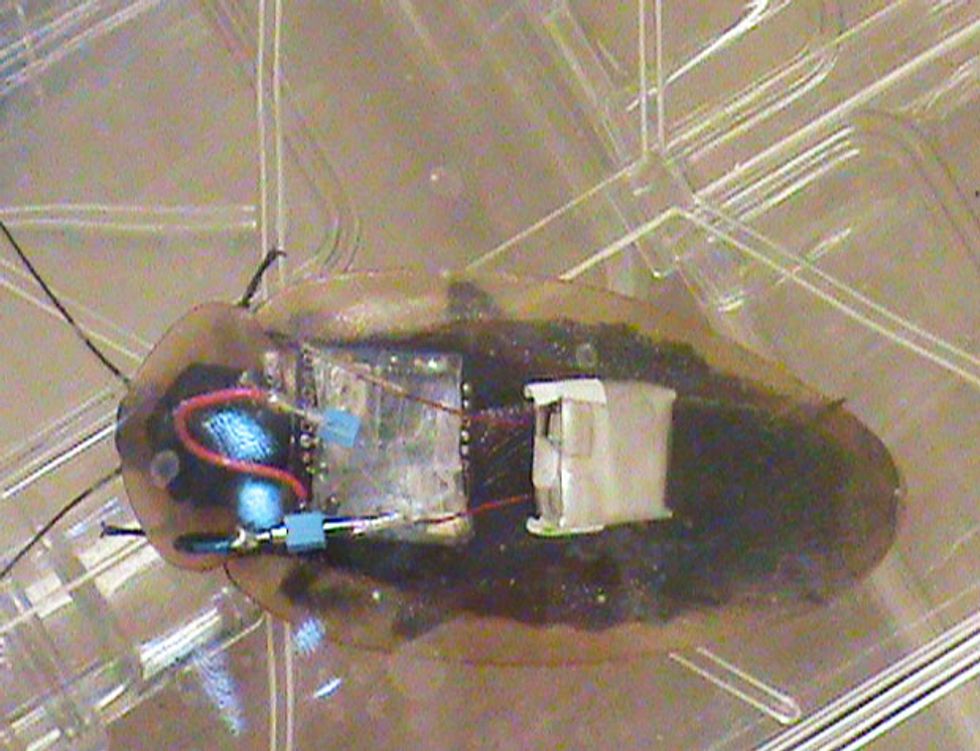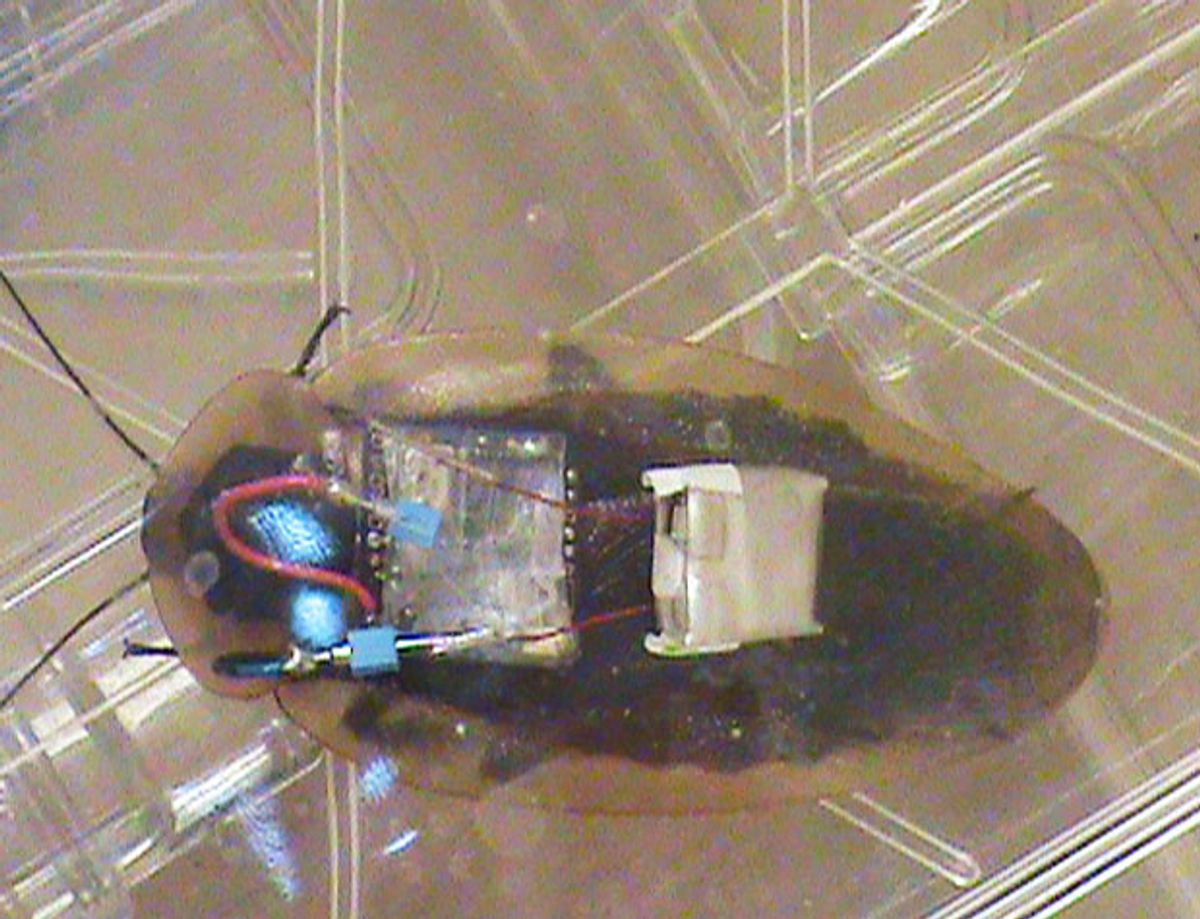
You’re pinned under the rubble of a collapsed building. Hundreds of roaches scuttle toward you, but you’re unable to move. You can only watch as a great brown swarm closes in. But there’s something different about this approaching army of bugs. Each one hefts a coin-size sensor that’s glued to its back. The troop of roaches has been sent to rescue you.
That’s the scenario a team of Purdue University engineers has been working toward. This week at the Symposia on VLSI Technology and Circuits, in Japan, the group unveiled a new high-sensitivity, low-power wireless transceiver meant for insect-based wireless sensor networks. The transceiver can link to a variety of sensors. The researchers have already tested the technology using microphones, but it’s compatible with all sorts of other sensors as well, including those used for heat, light, position, acceleration, vibration, weight, pressure, humidity, and more.
“We can deploy these insects in areas that are contaminated by nuclear [waste] or by toxic chemicals,” says Byunghoo Jung, a professor of electrical and computer engineering at Purdue, in West Lafayette, Ind., who oversaw the group’s research. “Then those insects equipped with sensors and wireless communications can detect the toxic chemical levels and report that back to the base station. But that process takes some energy, because they need to use some wireless communications. The radio that you can put on top of these insects has to be very power efficient. That is why we designed such a radio that consumes ultralow power but still has very high sensitivity.”
You can think of each separate bug in the Purdue scheme as a sensor node—a component of a network that is capable of processing sensory information and communicating with other connected nodes in the network. Each bug backpack consists of a microcontroller (the processing unit), a sensor, an antenna, and a wireless transceiver. The roaches can either send data directly to a base station or pass data to other roaches closer to the base station.
The team chose death’s head cockroaches (Blaberus craniifer) as sensor nodes for certain advantageous traits: They’re fast, they can crawl through cracks, and their locomotion is powered by a diet of decaying plant and animal matter. (They’ll willingly devour feces or wood too, if their favorite nosh is in scarce supply.) But they have some limits. While a death’s head roach typically grows up to 5 to 8 centimeters long—it is a truly massive bug—it can carry a maximum of just 3 grams.
“[We] performed architecture and circuit-level optimizations to achieve [an efficient] sensor node design,” explains Serkan Sayilir, a doctoral candidate and member of the Purdue team. The group realized that the key was optimizing the wireless transceiver, the component that typically consumes the most power and requires many external components. “If we could optimize the transceiver, we could optimize the metrics,” Sayilir says.
The group first tried to design a sensor node using commercial components, but the effort came up short. “At 14 by 14 millimeters and less than 1 gram, the size and weight were okay,” Sayilir recalls. “However, the power consumption was greater than 100 milliwatts, and it was dominated by the wireless transceiver. So we designed a custom wireless transceiver.”
A transceiver chip consists of several blocks of circuitry, but the group’s breakthrough idea was to combine several of these blocks into one. Specifically, they merged the voltage-controlled oscillator, the power amplifier, the low-noise amplifier, the transmit/receive switch, and the modulator.
That move eliminated many of the redundancies in the chip, both for power and the number of components. The oscillator and amplifiers, for example, require inductors. “Inductors are very big in the integrated circuit design. In order to reduce the on-chip area, we wanted to minimize the number of inductors,” Sayilir says. The engineers were able to use the same inductors for the low-noise amplifier, the power amplifier, and the voltage-controlled oscillator.
Besides saving space, the unified blocks saved power. For example, in transmit mode, the design uses the same current in the voltage-controlled oscillator as in the power amplifier to drive the antenna. The engineers were able to turn the oscillator off for a fraction of the time, cutting power consumption in half. In addition, integrating the transmit and receive blocks let them toggle between modes easily so that the design didn’t need an external transmit/receive switch, explains Sayilir.
Sayilir emphasizes that even though the researchers discarded a number of usual parts and components, they didn’t sacrifice performance in any way. “It is better than existing works in many aspects,” he says.
This latest research by Purdue is far from being the first effort in the world of bionic bug engineering. Up until recently, a U.S. Defense Advanced Research Projects Agency (DARPA) program called Hybrid Insect Micro-Electro-Mechanical Systems (HI-MEMS) was actively conducting research. The program aimed to develop technology to provide control over insect locomotion, which would lead to steerable robot spies or rescue workers. That yielded a proposal for a cyborg moth, among other ideas, but the program was not renewed, and the research contracts eventually ran out.
Still, the work inspired Benjamin Epstein, vice president of special projects at systems and networking company OpCoast, in Brick, N.J., to think about building a network of insects that provide a robust communications system. “[HI-MEMS] focused on controlling the movement of insects by remote means,” he says. “And I said, let’s look at the communication part of it, because that part to me has been consistently ignored.”
Even though the DARPA insect program no longer exists, the U.S. military is still interested in this type of work. OpCoast secured a contract with the U.S. Army Research, Development and Engineering Command and subcontracted the team at Purdue to develop a wireless sensor node it could use.
Epstein, who entrusted the design of the chip to the Purdue team, was impressed with the work they turned out. “It was well-conceived,” he says. “They knew exactly what they wanted to do, and they executed.”
Currently, the Purdue engineers are refining a new scheme to link multiple sensor nodes in sequence, which would boost the network communication signal. This tactic is known as “daisy chaining,” in which nodes too distant to reach the base station transmit their data to roaches that are closer to it. “By connecting multiple sensors in daisy chains, we’ll be able to increase the actual communications distance instantly,” Jung says. “We have already conducted a peer-to-peer link test, where the [effective] distance is between 10 and 20 meters, depending on the set of conditions. But because our design is able to support the daisy chain, basically there could be no limit in terms of distance.”
He says the group has already managed to carry out a field test with three nodes connected in a chain. “Everything went smoothly; the initial setup process was time-intensive, though,” he recalls. Test videos show field technicians frantically scrambling to round up roaches that, when released, immediately made a beeline for any dark crevices they could find.
According to Jung, the group’s work on the sensor node is essentially complete. The only missing piece is figuring out how best to get the cockroaches to behave the way they want. “The development of a wireless sensor node light enough for the cockroach is in the prototyping stage beyond proof of concept,” Jung says. “However, training the cockroaches based on the understandings on their behavioral pattern is still in the early stage of development.”
But Epstein says there is one surefire way to overcome this limitation: “Releasing swarms of them. Statistically, some of them will go where we want them to go.”



